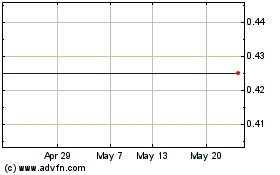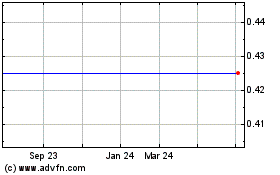Final Results
December 18 2007 - 1:09PM
UK Regulatory
RNS Number:2136K
Uranium Resources PLC
18 December 2007
URANIUM RESOURCES PLC
FINAL RESULTS
FOR THE YEAR ENDED 30 JUNE 2007
EXECUTIVE DIRECTOR'S STATEMENT
FOR THE YEAR ENDED 30 JUNE 2007
The financial year ended 30 June 2007 has been a year of corporate
reorganization, uranium exploration success and strong growth in the value of
Uranium Resources plc ("URA" or the "Company").
The first half of the year saw the completion of the change in board members of
your company to the present composition of Hugh Warner, James Pratt and Ross
Warner. Coupled with the reinvigoration of the board of directors, URA enjoyed
exploration success in Southern Tanzania and with this success the Company was
able to raise �2,000,000 in new equity to strengthen our balance sheet. The
second half of the year saw the announcement of further exploration results, the
acquisition of additional exploration tenements and further growth in the value
of your company.
The Company's primary focus has been on the exploration of its land holdings in
Southern Tanzania and the expansion of that land holding. In the first half of
the period under review channel samples from trenches at the Company's Henri
anomaly produced assays of up to 2.71% U3O8. The Company continued to expand
its land holding from approximately 7,600 sq kms in granted tenements to
approximately 10,850 sq kms in granted tenements and a further 2,700 sq kms in
applications. The Company notes that its key Henri area has been converted from
a Reconnaissance Licence to a Prospecting Licence granted 22 November 2007.
Included below is a more detailed summary of exploration activity carried out
during the period of review. Shareholders are encouraged to review the
Company's recently rebuilt web site at www.uraniumresources.co.uk where you will
find pictorial illustrations of the Company's recent successful exploration
programmes.
Finally I would like to remind shareholders that the Karoo Basin of Southern
Tanzania remains one of the least explored uranium provinces in the world and
its potential remains yet to be unlocked. The average historical expenditure on
uranium exploration in Tanzania has been US $4 /sq km compared to US $16 in
Western Africa and US $224/sq km in the United States (USGS). Yet the geology
is analagous to the sediments hosting Paladin's Kayelekera deposit 300 km away
in Malawi and the drilling success of URA and of Mantra 25 km to the north at
Mkuju River demonstrate the potential for a discovery in this under explored
province. The Board believes that this fact differentiates URA from many of its
competitors seeking exploration success in areas of intense historical
exploration by uranium majors. This has been demonstrated by the Company's
ability to rapidly delineate anomalies and generate exciting results at surface.
Exploration Activity in Detail
During the period under review, all uranium exploration was carried out by URA's
joint venture farm-in partner, Western Metals Limited (ASX: WMT).
During the fourth quarter ended 30 June 2007, extensive exploration activities
were conducted primarily focused on the Mtonya project where previous
exploration had identified a large trend of radiometric anomalies and high grade
surface uranium mineralisation.
In addition, significant logistical activities were undertaken following the end
of the wet season in late April, in order to improve access links to the Mtonya
project. Earth moving contractors were deployed to establish access to the Henri
area of the Mtonya project. The contractors completed a 12 kilometre road into
the main exploration area suitable for drilling equipment and the field camp was
established by the end of May. Subsequent to completing the main road the
contractors established spur roads to access the work areas to create further
drilling targets. This access now provides an important base for intensive field
work to be conducted with transport of equipment and supplies now being easily
managed.
Drilling
The aim of the fourth quarter drilling programme was to determine if subsurface
mineralisation existed below the radiometric anomalies and surface
mineralisation identified in previous field programmes.
Based on results to date, and in combination with the outstanding results from
surface trenching of up to 2.7% U3O8 in channel samples, the drilling programme
was a success having shown that strong subsurface mineralisation is present.
Intersection widths range up to seven metres and the results indicated multiple
mineralised horizons preferentially hosted in sandstone units frequently at or
near contact with mudstone units. This is typical for sandstone hosted roll
front style uranium deposits such as the Kayelekera deposit in neighbouring
Malawi.
Significantly, the results show that subsurface mineralisation occurs over the
entire Henri trend from Para to Tahbilk. The peak intersection of 1 metre at
470ppm U3O8 from the broad spaced drilling at Para supports the potential for
high grade mineralisation to exist over the entire trend. The Tahbilk anomaly
has returned a peak value of 1 metre at 140 ppm U3O8 from two broad spaced holes
potentially located off the main anomaly area.
Field work in 2006 highlighted many areas of potential with the Henri, Para,
Tahbilk, Galway Moysten, and Grandfather anomalies providing initial targets.
The June drilling programme tested Henri, Para and Tahbilk and follow-up
programmes are planned on these and other known targets.
Second Half Drilling Results
The Company reminds investors that this is the very first drill programme
undertaken for uranium in Southern Tanzania and the promise shown from these
very early results provide the Company with strong encouragement for the future
exploration of the Mtonya area and for its wider exploration effort.
Peak intersections above 100 ppm U3O8 cut-off achieved include:
* 7 metres at 1,233 ppm U3O8- including 3 metres at 2,607 ppm U3O8
* 7 metres at 549 ppm U3O8 - including 4 metres at 843 ppm U3O8
* 6 metres at 507 ppm U3O8 - including 2 metres at 1,145 ppm U3O8
* 7 metres at 400 ppm U3O8 - including 3 metres at 770 ppm U3O8
* 4 metres at 515 ppm U3O8 - including 2 metres at 855 ppm U3O8
Further drilling was conducted in August 2007 to test other anomalies and
continue evaluation of the area identified by the June programme.
Airborne Radiometric Survey
A high resolution helicopter radiometric survey was completed during the period
under review over the most prospective areas of the Mtonya project. The survey
comprised 5,150 line kilometres of data collection on 250 metre spaced flight
lines.
The interpretation of data has identified more than 15 anomalies of interest
that warrant further exploration and has provided more detailed definition of
anomalies identified from historic data. Field parties commenced accessing known
anomalies during June to conduct geological data collection and sampling.
Field Reconnaissance
A field party was deployed via helicopter during April-May to conduct
preliminary reconnaissance on anomalies identified from historic broad spaced
airborne radiometric surveys in the Ruhuhu project area to the west of Mtonya.
The work involved ground checking of selected anomalies, ground radiometric
surveys, geological observation and sampling.
The results of the reconnaissance are considered encouraging with one anomaly
giving a peak result of 2,500 counts per second at surface using a hand held
scintillometer. Further detailed exploration during the second half of calendar
2007 including drilling and detailed airborne radiometric surveys will be
conducted in the area.
Trenching and sampling of anomalies in the greater Henri Project area were also
conducted during the period under review in addition to a ground follow-up of
heli-radiometric anomalies.
Land Acquisition
URA acquired a Joint Venture interest in the reconnaissance prospecting licence
PLR 3467/2005 in the south west of Tanzania. The licence covers rocks of the
middle to upper Karoo sequence of the Ngaka Sub-basin in the Ruhuhu Basin. This
sequence includes layered sequences of mudrocks and fluvial sandstones suitable
for hosting sandstone style uranium deposits.
Previous work by Uranerzberbau GmbH ("UEB") in the early 1980s located a 129 ppm
U3O8 anomaly within a sandstone/siltstone outcrop within the tenement. No
further work has been conducted on this anomaly. Several untested airborne
radiometric anomalies identified from historic Geo-survey data also exist within
the area.
The ownership structure of this arrangement is;
* Uranium Resources plc 45%
* Western Metals 45%
* Tanzanian Partners 10% (free carry through to feasibility study)
Western Metals is the project manager of exploration activities in Tanzania
under the joint venture agreement.
In addition to the acquisition of PLR 3467/2005 two further Joint Venture
licences PLR4432/2007 and PLR4476/2007 were granted during the period taking the
total licence holding under management to approximately 10,850 sq kms in granted
tenement and 2,700 sq kms in applications.
November 2006 Field Trip
The results of the August and November 2006 exploration field program on the
Mtonya Uranium Prospect in Tanzania were the value driver for URA in the period
under review.
The November field program was completed successfully on 2 December 2006 with a
further 7 trenches excavated and sampled, bringing the total number of trenches
at Mtonya to 13. Detailed radiometric surveys were also completed at the Henri,
Para and Tahbilk anomalies.
Further afield, reconnaissance surveys were conducted over a 5 km trend to the
north east of Henri, identifying several new anomalies at Galway, Moysten and
Grandfather.
It was after the November field programme that we announced: 'The data collected
by Dr Drake-Brockman on the recent field trip further enhances the Company's
belief that the Mtonya system has the potential to host a significant ore body
and provides the Company with further immediate drill targets for our planned
drilling program in June 2007 post the upcoming wet season.'.
The Henri detailed radiometric survey has provided greater definition over the
known anomaly and identified a further six >200 cps anomalies within 250 metres
of the Henri discovery anomaly.
The surveys of the Para and Tahbilk anomalies have increased the extent of the
Mtonya anomalies. Trenching on these areas has also been completed to determine
the distribution of uranium near surface..
August 2006 Field Work Final Results
Trenching work conducted at Mtonya in August included excavating, sampling and
mapping 5 trenches at the Henri anomaly area and collecting surface samples from
sites of elevated radiometric response.
Trenches were dug to a depth of 1 to 1.5 metres. Channel samples and selective
grab samples were collected and the trenches were geologically mapped. Channel
samples were collected at 1 to 2 metre intervals along the length of the
trenches. Sample lengths were based on geological boundaries and collected
perpendicular to the generally sub-horizontal dip of the host geology.
Trench 1 and Trench 2 at the Henri anomaly showed visible yellow secondary
uranium mineralisation. Photographs of the project including the visible uranium
mineralisation are available on the Company's web site.
The assays received from the trenches showed high grade uranium was present in
Trench 1 and Trench 2 with lower results from Trenches 3, 4 and 5. The results
from Trenches 4 and 5 are interpreted to be from beneath the redox boundary
front. The assays remain elevated indicating they are within the mineralized
system.
Trench 1 and Trench 2 show continuous zones of uranium mineralisation. Of
significance is that both trenches remain strongly mineralized at the eastern
and western extremities and in the bases of each trench indicating that the
mineralisation is more extensive than these exposures.
Samples were also collected from the surface or shallow trenches (
Uranium (LSE:URA)
Historical Stock Chart
From Oct 2024 to Nov 2024

Uranium (LSE:URA)
Historical Stock Chart
From Nov 2023 to Nov 2024
